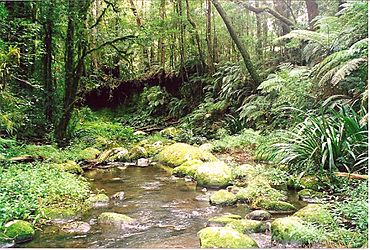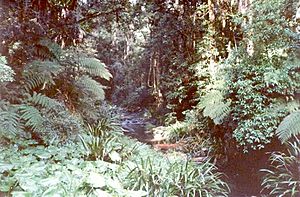Border Ranges National Park facts for kids
Quick facts for kids Border Ranges National ParkNew South Wales |
|
|---|---|
|
IUCN Category II (National Park)
|
|

Brindle Creek in the Border Ranges National Park is an impressive rainforest stream.
|
|
| Nearest town or city | Kyogle |
| Established | 8 June 1979 |
| Area | 317.29 km2 (122.5 sq mi) |
| Managing authorities | NSW National Parks & Wildlife Service |
| Website | Border Ranges National Park |
| See also | Protected areas of New South Wales |
The Border Ranges National Park is a special protected area in New South Wales, Australia. It's a national park, which means it's kept safe for nature. A small part of it even stretches into South East Queensland.
This huge park covers about 31,729 hectares. To give you an idea, that's like 31,729 football fields! It's located about 150 kilometers (about 93 miles) south of Brisbane. You can find it north of a town called Kyogle.
The Border Ranges National Park is super important. It's part of the Gondwana Rainforests of Australia. This whole area is a World Heritage Site. It was added to this special list in 1986. Later, in 2007, it was also added to the Australian National Heritage List. This means it's recognized as having outstanding value for everyone.
How the Park Was Formed
The Border Ranges area, including places like the McPherson Range and Tweed Range, was shaped by a giant ancient volcano. This volcano is called the Tweed Volcano. Over many, many years, wind and rain wore down the volcano. This process created the amazing mountains and valleys you see today.
Some parts of the old volcano, called volcanic plugs, are still visible in the park. These are like the hard centers of the volcano's vents. The park is famous for its tall, old Nothofagus moorei trees. These trees grow in cool, wet areas. You can drive about 64 kilometers (40 miles) on a gravel road through different types of rainforests here. These include warm, cool, and subtropical rainforests.
Amazing Plants and Animals
The Border Ranges National Park and nearby Lamington National Park are known as a biodiversity hotspot. This means they have a huge variety of plants and animals. It's a special place where plants from both northern and southern Australia meet. Because of this, you can find many unique species here. Some of these species are endemic, meaning they live only in this area. Others are rare or even endangered.
The park is home to many different animals. For example, the Hastings River mouse was thought to be gone, but it has been found again here!
In the lower parts of the park, you'll find eucalypt forests. These forests are home to eastern grey kangaroos and red-necked wallabies. You might even spot a koala! Smaller animals like pademelons and potoroos also live here. The park is also a paradise for birds. You can see many different kinds, including the rare Albert's lyrebird. This park is part of the Scenic Rim Important Bird Area. This means BirdLife International has identified it as a key place for protecting several threatened bird species.

Things to Do and See
If you visit the park, you can find two campgrounds. One is for cars and campers, and the other is for walk-in tent camping. There are also several picnic areas. Some of these spots have shelters, water, and composting toilets.
One great picnic spot is at Blackbutts Lookout. From here, you get amazing views of Mount Warning. You can also see the Tweed Valley. This valley is a huge erosion caldera. It was formed when the ancient Tweed Volcano collapsed. Even though the sea breaks into it on one side, it's considered even bigger than the famous Ngorongoro Crater in Tanzania!
See also
 In Spanish: Parque nacional Montes de la Frontera para niños
In Spanish: Parque nacional Montes de la Frontera para niños




